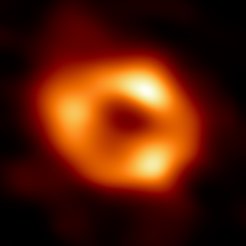Tycho Brahe Medal awarded to Anton Zensus
MPIfR director receives prestigious award of the European Astronomical Society
The 2023 Tycho Brahe Medal is awarded to Prof J. Anton Zensus (Max-Planck- Institute for Radio Astronomy, Bonn, Germany) for major advances of Very Long Baseline Interferometry that led to the first images of the shadows of the black holes in the galaxy Messier 87 and in our own Galactic centre. The Tycho Brahe Medal of the European Astronomical Society honours outstanding scientists in recognition of the development or exploitation of European instruments or major discoveries based largely on such instruments.

Anton Zensus, Director at the Max Planck Institute for Radio Astronomy (MPIfR) and head of MPIfR’s Radio Astronomy / VLBI research department, is recognized for his leadership over decades in advancing radio astronomical observations with extreme angular resolution and sensitivity. By the early 1980s, the astronomical technique of Very Long Baseline Interferometry (VLBI) had been pioneered as the most powerful means of studying and ultimately imaging the structure in the central regions of active galactic nuclei. At that time, VLBI was optimized for centimetre radio waves, and achieved imaging details on the scale of light years, enough to study details in the jets but not to resolve the central core thought to harbour the central engines.
Much higher resolutions were needed to confirm the prediction that the central engines consist of supermassive Black Holes, requiring the extension of VLBI to shorter mm wavelengths or even beyond the size of the Earth with orbiting radio telescopes.
As Director for VLBI at the MPIfR, Anton Zensus and his team tackled this challenge and used the IRAM telescopes at Pico Veleta and Plateau de Bure to tie both telescopes at 1.3 mm wavelength to find interferometric fringes. Transatlantic fringe detections followed, and they created with international partner organisations the Global millimetre VLBI Network, which produced reliable output of research data at 3 mm. The next technically feasible step was to select telescopes capable of observing at 1.3 mm, among those the two IRAM telescopes, APEX, and also ALMA, and equip them with the necessary hardware and software. Again, first experimental fringes were obtained from both sides of the Atlantic.
Since the late 1970s, computations of the vicinities of black holes showed that the event horizon of a supermassive black hole should be observable as a dark “shadow” with an angular size that relates in a simple way to the distance of the object, and its mass against the distorted background of its surrounding gas emission. The small size of the expected shadow, even for the most promising candidates, M87 and our Galactic Centre, confirmed the long-standing expectation that such observations would require a significant improvement of existing observing systems, and an efficient collaboration on a global scale. This became the Event Horizon Telescope (EHT) Collaboration. The EHT made 1.3 mm observations with an array of telescopes distributed across Europe, the Americas, Oceania and Antarctica achieving an angular resolution of 20 micro-arcseconds, required to successfully image the black holes in both candidates.
As well as confirming the masses derived by other methods, these measurements have allowed the shadow of the black hole to be imaged against the relativistic matter orbiting it within a few Schwarzschild radii. This is significantly closer than other methods permit, entering the realm where the effects of General Relativity are most significant. Anton Zensus played a key and foundational role from the outset, most visibly in his critical central role as the Founding Chair of the EHT board. He succeeded in brokering and maintaining the necessary but complex synergies between different and initially competing groups in Europe, the USA and Asia, which ultimately paved the way for the success of the EHT.
“I am delighted to be honoured with the Tycho Brahe Medal of the European Astronomical Society in this year. It acknowledges our efforts to pave the way closer and closer to the innermost regions and the central engines of Active Galactic Nuclei, ultimately leading to the shadows of the supermassive black holes at the centres of our Milky Way and the gigantic galaxy Messier 87,” concludes Anton Zensus.

Biographical Note:
Prof. Dr. J. Anton Zensus obtained his PhD from the University of Münster in Germany, and worked as a postdoc and staff scientist at the California Institute of Technology and the National Radio Observatory, He is recognized for a cutting-edge research and technology program, especially for his leading contributions to the research of Active Galactic Nuclei (AGN) and their radio cores and jets through intercontinental Very Long Baseline Interferometry (VLBI). Anton Zensus has led pioneering technological and methodological breakthroughs: among these are critical improvements of VLBI polarisation performance, accurate positional measurements from VLBI data, and detailed analysis of the two-dimensional structure of radio emission. Zensus and his team developed several generations of digital recording equipment, developed and operate a massive VLBI correlation facility adapted for space- and mm-VLBI processing, and delivered critical components of the ALMA phasing system. As Founding Chair of the Board of the EHT Collaboration, Prof. Zensus has made important contributions to all aspects of the research programme.

